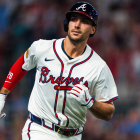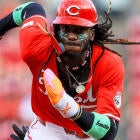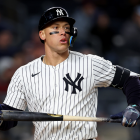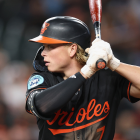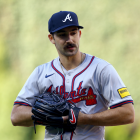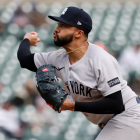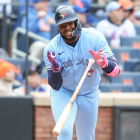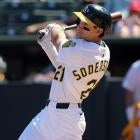The Texas Rangers are hitting their stride. They've won five of their past six games, allowing just 16 runs in that stretch ... with nine of those 16 coming Wednesday night, in a game they won handily anyway. Though they still trail the Mariners by a game and a half in the AL West, the Rangers own the third-best record in the American League.
Things could improve dramatically very soon. Though the Rangers could be primed for another playoff run this year, few teams are better positioned to make a pair of upgrades that rival what Texas could pull off very soon. While many other clubs will likely roll with what they have at least until the trade deadline approaches, the Rangers stand poised to dramatically upgrade both their starting rotation and their lineup ... simply by slotting in players already in the organization.
The first such upgrade will happen Saturday, and it should be pretty simple. That's the day Yu Darvish is slated to return to the rotation.
The Rangers ace hasn't pitched in the big leagues since Aug. 9, 2014. He missed the final seven weeks of that season with elbow inflammation, but seemed likely to return at full strength the following spring. Instead, he underwent Tommy John surgery, costing him all of last season. Returns from TJ are never easy. There's always concern that the recovering pitcher could need a while to ramp up his velocity, and even longer to regain his command.
So far, though, Darvish has looked good on both fronts. His most recent start, at Double-A Frisco on Sunday, was a gem. In six efficient innings, he tossed 87 pitches, with 56 of them going for strikes. He shut out the visiting San Antonio Missions, allowing just three hits and one walk, while striking out six. What's more, he found that elusive combination of velocity and command. As WFAA and Baseball Prospectus writer Kate Morrison noted, Darvish fired 96-mph fastballs early in the game, then found success with well-placed cutters and sinkers later in his dominant start.
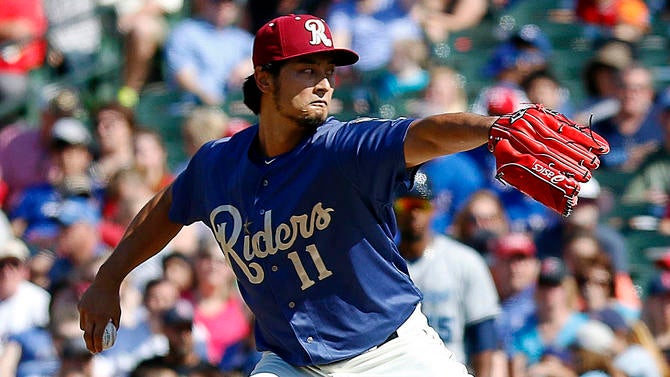
The Rangers will likely cap Darvish's pitch count at 85-90 pitches when he makes his return to the majors Saturday against the Pirates. The hope is that this cautious approach during his rehab and his initial return will enable Darvish to hold up for the rest of the season, and maybe into the playoffs; Matt Harvey's post-TJ return famously caused waves of consternation in New York last year.
Moreover, the Rangers could really use the boost. Derek Holland has been ineffective after coming back from his own injury-marred 2015, tossing up a 5.21 ERA. Cesar Ramos had allowed only two runs combined over his past two starts, but he's a swingman who likely wouldn't hold up long term in the rotation.
Even the rotation's three supposed mainstays haven't been as good as their superficial numbers might suggest. Cole Hamels, Martin Perez, and Colby Lewis all sport ERAs of 3.38 or lower ... but all three have also flashed much worse fielding-independent results, with Perez ranking among the league leaders in walks, and Hamels and Lewis serving up a blizzard of home runs. Rangers opponents are hitting 19 points lower with runners in scoring position than overall, a fortuitous situation that might not last much longer. A big Darvish boost would thus be most welcome.
Meanwhile, the Rangers could upgrade their offense with one simple move as well. Problem is, the politics behind that move are far more complicated.
By Wins Above Replacement, Prince Fielder is the worst everyday player in the entire American League. Wins Above Replacement is a catch-all stat that's meant to measure all kinds of contributions, ranging from hitting to baserunning to defense, and by extension the position a player occupies. As a designated hitter, Fielder obviously offers no defensive value. He's perennially one of the worst baserunners in the game. Which means that for him to help the Rangers, he needs to hit the snot out of the ball.
Name your favorite offensive stat, and Fielder comes out looking terrible no matter what. He's batting .193, slugging just .281, and sporting a measly .269 on-base percentage. He's managed a feeble two home runs. Adjust for the hitter-friendly Arlington environment in which he plays his home games, and Fielder isn't just the worst overall player in the American League ... he's the worst hitter, too.
Even with those miserable numbers, there are multiple arguments that favor keeping Fielder in the lineup. First, we're just past the quarter-pole of this season. As research done by excellent Baseball Prospectus writer Russell Carleton reminds us, 40-some games isn't a large enough sample to make sweeping judgments about a player. Second, Fielder is owed $24 million a year through the 2020 season; even after subtracting the $30 million kicked in by the Tigers to defray some of that contract, that still leaves the Rangers with a vested interest in seeing Fielder succeed.
Except here's the thing: You can punch a hole through both those arguments pretty quickly.
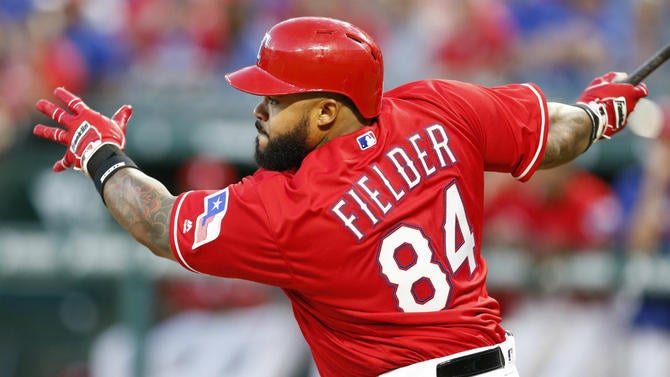
Consider the depths of Fielder's struggles. This isn't just a bad start -- these are the two worst months of his career. More frighteningly, Fielder's flailing isn't new. Though his full-year 2015 line looked good (.305/.378/.463, 23 homers), he was a very different player in the first half of last season (.339/.403/.521, 14 homers) than he was in the second half (.264/.348/.394, nine homers). Fielder's hit eight long balls in his past 97 games. That's appallingly weak performance for a player who offers little of value except power.
As for the financial argument, the Rangers owe Fielder that money regardless; in economic terms, he's what's known as a sunk cost. So if they're going to flush tens of millions of dollars down the toilet no matter what, probably best to find someone who can actually produce when given regular playing time.
At age 32, with underlying numbers that make you wonder if he's losing bat speed, Fielder simply might not be that guy anymore. When the Rangers smacked the Angels for 15 runs and 18 hits on Wednesday, only one player failed to record a hit: Fielder. Few Rangers fans were surprised. If anything, Rangers connoisseurs are already writing up spell-binding fanfic, imagining what might have happened had Texas not traded productive and popular second baseman Ian Kinsler for Fielder three years ago, only to watch Fielder fall apart while Kinsler absolutely rakes in Detroit.
Hypothetical scenarios aside, the Rangers do have a potentially dynamic Fielder replacement waiting in the wings: Joey Gallo. The lefty-swinging slugger came into last season as a top-10 overall prospect, according to both Baseball America and MLB.com. He hit an off-the-charts .314/.425/.636 at Double-A Frisco, further stoking the hype machine. That's when his weaknesses jumped to the surface: Gallo smashed 20 homers in 89 games across Triple-A and the big club over the rest of the season ... but he also struck out a ludicrous 147 times and hit below .200. That whifftastic performance, combined with the presence of Fielder, Adrian Beltre, Mitch Moreland, and a seemingly improved outfield, left no room for Gallo to come north with the big club this spring.
Times have changed. In 106 plate appearances at Triple-A Round Rock this year, Gallo hit .265 ... but with a magnificent .415 on-base percentage, and a robust .639 slugging average. He cut his strikeout rate sharply, fanning 24 times. And he showed much better command of the strike zone in general, drawing 22 walks.
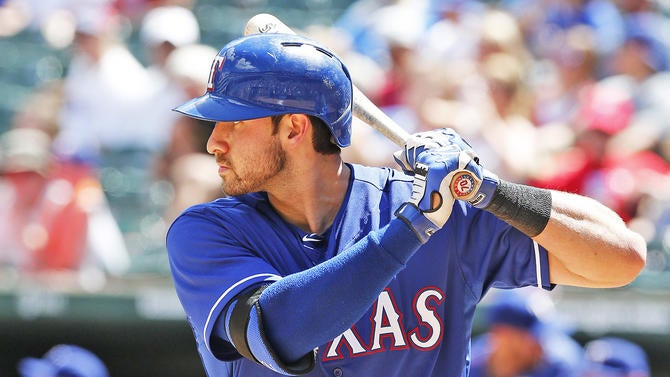
The Rangers called Gallo up on Monday, and he's come to bat just once since then. He'll likely earn more playing time soon, with Shin-Soo Choo and Drew Stubbs on the disabled list, and Moreland hitting poorly.
Dig into the advanced stats and you can see that the lineup, like the rotation, hasn't been all that good, and has benefited from a fair bit of good luck. The Rangers are at their best when they allow their perennially excellent farm system to feed the major league roster. So Gallo could join the dynamic Nomar Mazara in giving the team the big homegrown lift it needs to vie for another playoff spot.
The question is, if Gallo does hit as hoped, and the rest of the roster gets healthy/reverts to career norms, where will Fielder be at that point? Talking in abstract terms about sunk costs is one thing. But if the owner of arguably baseball's worst contract still isn't hitting a lick a few weeks from now, will Jon Daniels and the rest of the front office have the moxie to bench the big guy ... or if Fielder's struggling keep going, maybe even to pay another team to take him off their hands?
The fate of the AL West may well rest on Darvish returning to ace form, and on Fielder's bosses swallowing a lot of pride, and even more money.
![[object Object] Logo](https://sportshub.cbsistatic.com/i/2020/04/22/e9ceb731-8b3f-4c60-98fe-090ab66a2997/screen-shot-2020-04-22-at-11-04-56-am.png)









